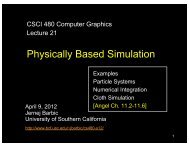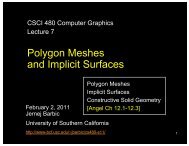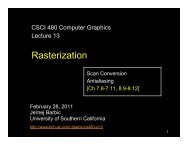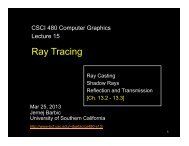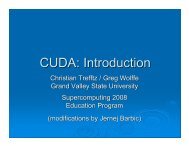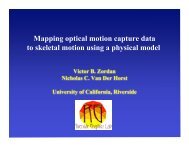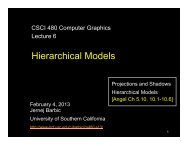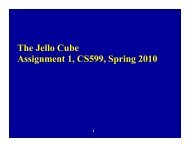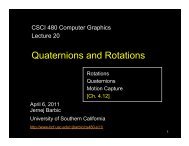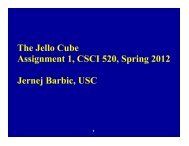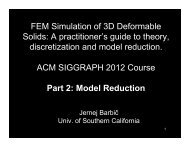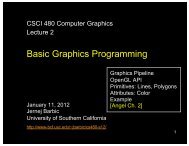Vega FEM Library (v1.1) User's Manual - University of Southern ...
Vega FEM Library (v1.1) User's Manual - University of Southern ...
Vega FEM Library (v1.1) User's Manual - University of Southern ...
You also want an ePaper? Increase the reach of your titles
YUMPU automatically turns print PDFs into web optimized ePapers that Google loves.
<strong>Vega</strong> is a library for 3D solid simulation 1 . The input to <strong>Vega</strong> is a 3D volumetric mesh with material<br />
properties, as well as (time-varying) external forces to act on the 3D mesh at each timestep. <strong>Vega</strong> computes<br />
the displacements <strong>of</strong> mesh vertices at each timestep, as well as the internal elastic forces and their gradients<br />
(tangent stiffness matrix). Two mesh elements are supported: linear tetrahedra and axis-aligned cubes.<br />
<strong>Vega</strong> includes libraries for sparse matrix storage and arithmetics, volumetric mesh storage, code performance<br />
timing, and mesh rendering using OpenGL. For sparse linear system solving, <strong>Vega</strong> can use PARDISO [PAR],<br />
SPOOLES [SPO], or conjugate gradients. The included (Jacobi-preconditioned) conjugate gradient solver<br />
was written by Jernej Barbič by following the well-known reference [She94]. <strong>Vega</strong> also includes an elaborate<br />
example driver (executable) simulator to interactively test the implemented materials, timestepping methods,<br />
and other settings. Several example meshes and configuration files are included to demonstrate the various<br />
materials. We provide detailed experiments on the performance <strong>of</strong> <strong>Vega</strong> in [SSB12].<br />
Finally, we find it useful to also state what <strong>Vega</strong> currently does not support. <strong>Vega</strong> currently supports<br />
3D solid simulation on volumetric meshes; it does not support cloth and strands. It uses linearized tets and<br />
axis-aligned cubes for mesh elements; higher-order elements are not supported. <strong>Vega</strong> solves linear systems<br />
<strong>of</strong> equations using preconditioned conjugated gradients or direct sparse solvers. It does not incorporate<br />
solver acceleration strategies such as multigrid. It does not implement inverse kinematics, or space-time<br />
optimization. It does not simulate rigid bodies, articulated rigid bodies or fluids. It does not support mesh<br />
cutting or other run-time mesh modifications; although mesh material properties could be altered at run-time<br />
without much difficulty. While it does not incorporate collision detection or contact resolution, it is possible<br />
to use any external collision detection library, compute forces externally, and set them as external forces in<br />
<strong>Vega</strong>. A more elaborate contact solver could be written by using <strong>Vega</strong>’s routines to compute internal forces<br />
and stiffness matrices in arbitrary mesh configurations.<br />
1.1 Compiling <strong>Vega</strong><br />
<strong>Vega</strong> is designed to be cross-platform. We have successfully compiled it on Linux, Windows and Mac OS X.<br />
We provide makefiles (make command) for Linux and Mac OS X.<br />
The first step is to select either Makefile-headers/Makefile-header.linux, or<br />
Makefile-headers/Makefile-header.osx, depending on your OS. By default, linux is selected. The selection<br />
is made by creating a s<strong>of</strong>t link Makefile-headers/Makefile-header that points to the selected<br />
Makefile. To switch to MAC OS X, use:<br />
cd Makefile-header;ln -sf Makefile-header.osx Makefile-header.<br />
Alternatively, you can switch using the provided scripts Makefile-headers/selectLinux or<br />
Makefile-headers/selectMACOSX.<br />
To compile the entire set <strong>of</strong> libraries and the interactive simulator in one step, move to the<br />
utilities/interactiveDeformableSimulator folder and run $ make. To compile an individual library<br />
libraryName, along with all the libraries it depends on, move to libraries/libraryName and run $ make.<br />
The script ./build combines Makefile-header selection and the compilation into one step.<br />
To clean all the compiled files (for the interactive simulator and for all the libraries), move to<br />
utilities/interactiveDeformableSimulator and run $ make deepclean. To only clean the simulator<br />
folder, run $ make clean. Similarly, running $ make deepclean in folder libraries/libraryName will<br />
clean the folder for libraryName as well as those <strong>of</strong> all the other libraries libraries it depends on, whereas<br />
running $ make clean will only clean the libraries/libraryName folder.<br />
Dependencies: <strong>Vega</strong> has no required external dependencies. It includes all the necessary components<br />
for deformable object simulation. It uses its own CG solver as the default solver for implicit integration.<br />
This solver can be substituted for external linear system sparse solvers such as the PARDISO or SPOOLES.<br />
Other solvers can be easily added as well. The provided demonstration driver uses OpenGL for visualization:<br />
it depends on the GL, GLU, GLUT OpenGL libraries. It also depends on the GLUI User Interface <strong>Library</strong>,<br />
which is used for the driver’s user interface (buttons, edit boxes, etc.). This external library (LGPL license)<br />
is included with the <strong>Vega</strong> distribution (in libraries/glui), unmodified as it was downloaded from http:<br />
//glui.sourceforge.net/. The provided Makefiles will automatically compile GLUI to a shared library<br />
1 extensions to shell (cloth) and strand models are possible<br />
2



